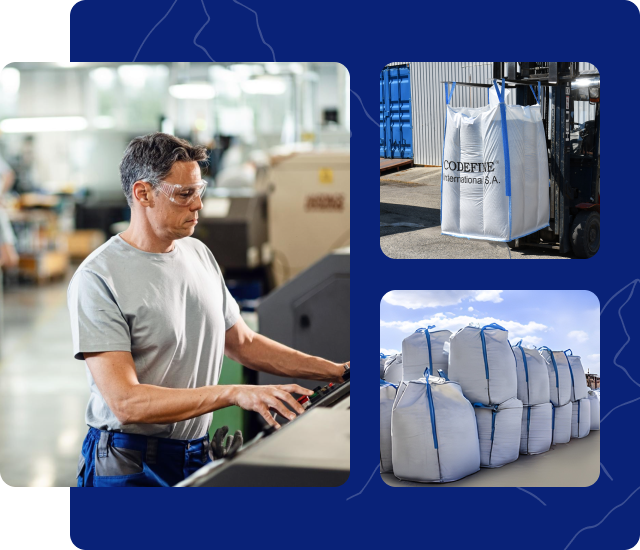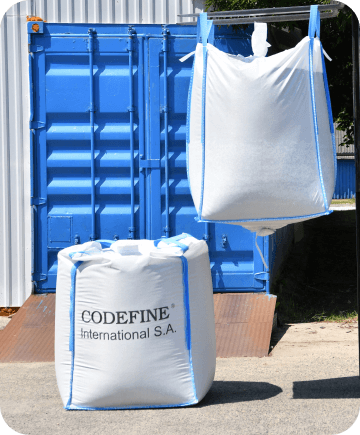Home » Posts Page » Blog » Products and Materials » Protective Packaging: Why Polypropylene Bags Are Ideal for Moisture-Sensitive Materials

You’ve got several packaging options to fight this battle, including FIBCs (Flexible Intermediate Bulk Containers), container liners, jute bags, and woven polypropylene (PP) bags. But here’s the thing: woven polypropylene bags have become the go-to choice for businesses that need solid moisture protection without destroying their budgets or compromising quality standards.
Think of protective packaging as armor for your products. It’s the materials and systems that keep sensitive goods safe from environmental threats like moisture, contamination, and physical damage while they’re being handled, shipped, or stored. This specialized packaging acts as your first defense line for maintaining product quality, extending shelf life, and keeping safety standards intact throughout your entire supply chain.
Agriculture and pharmaceutical companies face particularly high stakes here. Even tiny amounts of humidity or contaminants can wipe out shipments worth thousands or millions of dollars. Good packaging strategies cut these losses while reducing regulatory headaches and keeping customers satisfied by ensuring products arrive exactly as they left your facility. The pressure intensifies when you’re dealing with products that have strict storage requirements or become useless quickly once they’re exposed to environmental factors.
Moisture wreaks havoc on both perishable and shelf-stable products across countless industries. It changes chemical compositions, encourages mold growth, and creates expensive problems that smart packaging choices could easily prevent.
Grains, seeds, powdered pharmaceuticals, and food ingredients get hit hardest when humidity creeps in. High moisture levels trigger mold growth, slash shelf life, and sometimes make entire batches worthless. Industries with strict compliance rules like food processing and pharmaceutical manufacturing face consequences that go way beyond immediate money losses. Failed inspections, regulatory penalties, and costly recalls can trash your brand reputation for years while creating legal problems that make the original issue look minor.
Traditional materials like untreated paper sacks and basic jute bags fall apart quickly in wet conditions. They lose their strength, stack poorly, and tear or collapse easily during normal handling. Packaging for moisture-sensitive products needs to hold up when environmental conditions change while providing consistent protection that doesn’t weaken over time or fail under pressure.
Woven polypropylene bags are built specifically to handle the challenges that come with storing and moving moisture-sensitive materials. When they’re coated or laminated properly, these bags provide excellent water resistance that protects products from humidity and damaging light that could ruin product quality. The woven construction gives them serious strength and puncture resistance, which becomes essential when products get rough treatment during transport and storage.
These bags also offer flexibility that works with different filling and discharge methods, making them easy to integrate into your existing automated systems without major operational headaches. For products that actually need some airflow like certain produce or grains that require breathing room, uncoated PP bags provide ventilation while keeping their protective shape and structural integrity.
This balance of water resistance, strength, and operational flexibility has made polypropylene bags the preferred choice for supply chains that need both protection and efficiency.
Paper sacks, polyethylene bags, and woven fabrics all have their place, but when moisture protection becomes your main concern, polypropylene consistently outperforms the competition across multiple criteria.
Cost-wise, PP bags deliver better long-term value through superior durability. Their strength means fewer damaged packages during transport and storage, which cuts replacement costs and makes them more economical for high-volume operations handling thousands of units. The upfront investment in quality polypropylene packaging typically pays for itself through reduced loss rates and fewer handling problems.
For barrier strength and load stability, polypropylene beats many traditional alternatives hands down. Paper loses its integrity when wet, while standard polyethylene tears under heavy loads or rough handling. PP bags keep their shape and continue protecting contents even under challenging conditions. Their puncture resistance and ability to stay stable under heavy stacking pressure make them perfect for warehouse storage and long-distance shipping where reliability matters most.
Across different industries, woven polypropylene bags have proven themselves in demanding real-world situations where product protection directly affects business success. Agricultural operations use these bags extensively for seeds, grains, and fertilizers, getting reliable protection from external moisture and internal condensation that builds up during storage in changing temperatures.
Pharmaceutical companies depend on polypropylene bags to store and ship powdered APIs and supplements, often adding specialized liners for extra protection that maintains product purity throughout distribution. The ability to keep sterile conditions while preventing moisture makes these bags particularly valuable for sensitive pharmaceutical applications where contamination could cause serious health problems.
Food manufacturers regularly choose polypropylene bags for dry products like sugar, flour, rice, and bulk ingredients, taking advantage of food-grade safety certifications and proven spoilage resistance. These bags maintain product freshness while handling the tough requirements of food processing facilities where efficiency and hygiene standards must work together. Chemical producers favor them for powders and granules, knowing their packaging can withstand both the chemical properties of their products and environmental exposure without breaking down or losing containment integrity.
Codefine skips the generic, one-size-fits-all approach and instead provides custom-engineered polypropylene bags and packaging systems designed for specific client needs and industry standards. Whether you’re handling delicate powdered pharmaceuticals that need sterile conditions or bulk agricultural goods requiring robust protection during long transport periods, the Codefine team works closely with clients to create packaging solutions that perform reliably under real-world pressure and environmental challenges.
Their solutions include custom sizing for specific product volumes and handling requirements, advanced coating and lamination technologies that boost moisture protection beyond standard offerings, and optional liner systems providing double-layer security for sensitive applications. Through maintaining strict quality standards and leveraging extensive global logistics expertise, Codefine ensures protective packaging works effectively in actual supply chain operations where variables can’t always be controlled, not just in controlled testing environments.
For businesses handling products sensitive to moisture, packaging choices represent strategic decisions that impact product quality, operational efficiency, customer satisfaction, and regulatory compliance. Polypropylene bags provide proven, reliable, and cost-effective ways to maintain product integrity, reduce spoilage losses, and ensure smoother logistics operations that meet demanding delivery schedules without compromising quality standards.
Partnering with Codefine means more than finding a packaging supplier; it means choosing solution providers that engineer packaging systems specifically designed for real-world challenges while maintaining competitive pricing and reliable performance. The combination of technical expertise, customization capabilities, and quality commitment makes them ideal partners for companies seeking to optimize their protective packaging strategies while building resilient supply chains that adapt to changing market demands and environmental challenges.
